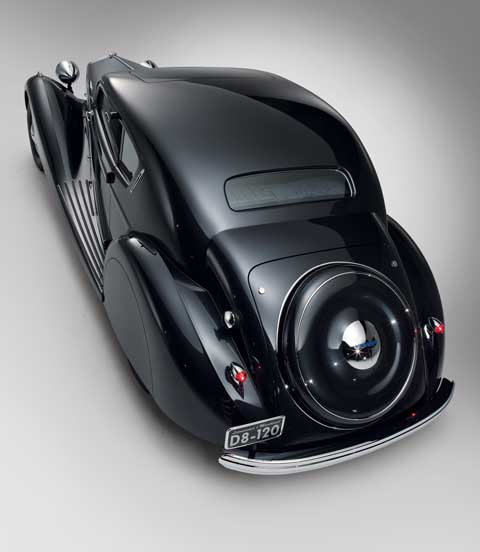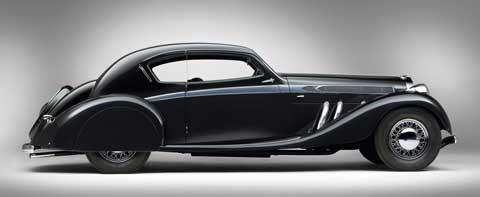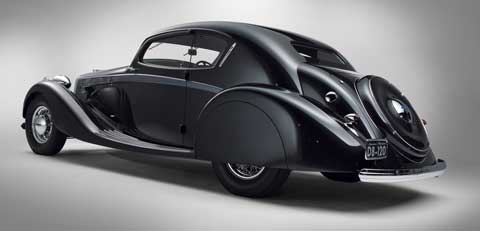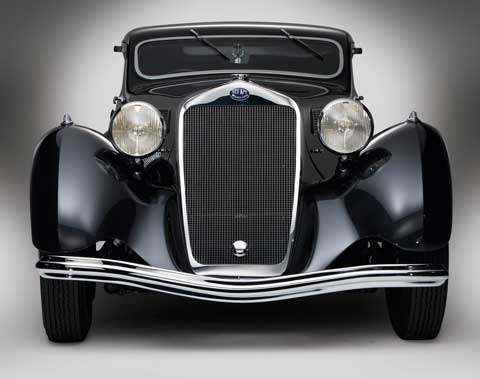 Photo courtesy RM Auctions.
Photo courtesy RM Auctions.
By Pete Vack with help from RM Auctions
The answer to “What is it worth?” relevant to classic Delages was answered this past Friday at the RM Automobiles of Arizona Auction in Phoenix.
The 1937 Delage D8-120 Aerosport Coupe brought $825,000 and was purchased by an international collector who is now concentrating on the Delage marque. Only three other cars at the auction sold for more.
 Photo courtesy RM Auctions.
Photo courtesy RM Auctions.
The answer to “What’ll she do?” can be ascertained from both Road & Track and an Autocar road test which was reprinted in Volume Two of “Delage, France’s Finest Car”. The body styles, and therefore weight varied, as did the hp, but the 4744cc straight eight produced between 115 and 142 hp, and propelled the 4000 lbs. plus car from zero to sixty in around 17 seconds, the quarter in about 20 seconds, and top speed just under 100 mph.
 Photo courtesy RM Auctions.
Photo courtesy RM Auctions.
Mechanically, the Delage offered a Cotal four-speed electric pre-selector gearbox, independent front suspension with transverse leaf spring and trailing arm, live rear axle with longitudinal leaf springs, and four-wheel hydraulic drum brakes on a 133 inch wheelbase. This car, with the 4744 cc engine, was probably an S model, as the normal D8 120s were of only 4302cc in displacement.
The coachwork of the car sold at the RM Auction (chassis 50789), was designed and constructed by the famous French firm of Letourneur et Marchand. According to the authors of “Delage. France’s Finest Car”, the design was originally given the codename “JELM; J was used to designate a two door saloon, and the “LM” stood for Letourneur et Marchand. The key styling motif for this style was the lack of a B pillar, making the body in effect a hardtop coupe. A number of these pillar less saloons were built on Delage D6-70 chassis, and a few on the later Delahaye-based D8-120s. “The D6-70 ‘panoramic saloons’ would dominate articles and garner a rich harvest of cups and prizes in concours d’ elegance,” wrote the authors. The model name “Aerosport” was also associated with the hardtop coupe. Ironically, the Letourneur-Marchand Aerosport coupe would linger as an option on Delages until 1953, just as Delage was on its final deathbed and the hardtop coupe was to become all the craze in America.
But what did we say about being based on the Delahaye? As we’ll see in more detail next week, after 1935, Delage was sold to Delahaye, and most Delages made after 1936 were actually badge engineered Delahayes, including the D8-120s, which were built on a Delahaye chassis equipped with a Delahaye engine, a 135MS six with two more cylinders for the luxury trade.
 Photo courtesy RM Auctions.
Photo courtesy RM Auctions.
The following description is a synopsis from the RM Auction Catalog:
This Delage is believed to be the sole surviving example of approximately ten cars that were originally built with the notchback coupe body, Style Number 5677. While there is no question about the provenance of this car, little is known of its early history beyond having been sold new in France. Sometime following the end of World War II, chassis 50789 went to Australia. Considered little more than a used car by that point in time and with parts increasingly difficult to obtain, the car fell into a state of disrepair. Thankfully, 50789 was discovered and purchased by Richard Scott of Sidney, Ohio. The Delage was shipped to the United States, where he began a comprehensive restoration with the objective of preparing the car to win on the lawn at the prestigious Pebble Beach where it received a Second Place Award for European Classic 1925-1939 Closed automobiles.
As a previous owner of this Delage I can add a little more information on its history. It was purchased in France shortly after WWII by Gaston Saint. Whilst in France he had the body ‘updated’ by Letourneur and Marchand by having the front mudguards modified to have the headlights faired into the inner edge of the ‘guards.
The car was shipped to Australia where it spent its time based at Mr Saints farm outside Castlemaine in central Victoria. Being a large, heavy and powerful car it was ideally suited to very fast driving on the gravel roads in the area, something that, according to his son, Mr Saint delighted in, particularly as it was considerably faster than almost all the other cars in the area at the time.
The rough roads did take their toll as eventually the upper front suspension arms cracked and were repaired in a somewhat agricultural manner by being encased in two sections of heavy angle iron forming a box welded around the length of the arm leaving only the mounting points at each end exposed. The description on the RM auction page for this car refers to the car having suffered a front end accident however I think that the heavily repaired suspension arms together with the updated mudguards and a damaged radiator shell and grille may have led them to a mistaken conclusion. The radiator shell and grille were in fact damaged when off the car by being trampled by a small group of cows seeking shelter in a thunder storm in the shed the car was being stored in.
As originally built and certainly as imported into Australia the car did not have the rear wheel spats currently fitted to the car although I must say they do look smart.
Whilst a little difficult to see in these photo’s the upholstery appears to be of a different style to that originally fitted. Looking at the small section of upholstery visible through the rear window the upholstery seems to be vertically pleated leather. During the ’30’s pleated upholstery of this style was usually confined to cheaper cars as it meant that leather seats could be made using smaller pieces of leather sown together which in turn meant that less hide would be lost to offcuts and any blemishes in the leather could by either concealed or cut out without losing too much of the hide.
This car had plain unpleated leather upholstery front and rear which required larger unblemished hides and which resulted in less than optimum use of the total area of the hide theoretically available and was as a result only used on cars where cost was not a consideration.
Cheers
Dale Allen
Hi
Further to my earlier post, there are a few things I forgot to mention.
Th Cotal gearbox is not a pre-selector box, it is an epicyclic box which uses electo-magnetic discs to engage the desired gear set. It uses a conventional clutch for starting from a standstill and from there all changes are made without use of the clutch pedal. Smooth gear changes are made using the finger tip selector mounted to the left of the steering column. The discs provide enough slip in the take up stage to ensure the changes are made smoothly and without jerkiness.
The nature of the box is such that a reverse gear is not practical to include as part of the epicyclic set up so instead a simple reversing gear set is included on the output shaft to handle this function.
An interesting by-product of this is that this enables the use of all 4 gears in reverse. As the reverse gear mechanism is geared down it means that the car can probably only do, perhaps, 60 mph backwards. More than enough to get back to that hot blonde hitch hiker you just passed on the open road before anyone else can.
The instruments used in this car are not the originals that were with the car prior to restoration. The original instruments were Jaeger units with quadrant guages incorporated at the 3 and 9 positions on the Speed and Tach instrumentss. The original guages were a different colour scheme with the central square, where the needle pivots, finished in dark brown as were the 4 quadrant guages, Fuel, Temp, Charge and Oil Pressure. The background colour of the remaining area was a lighter brown. The colour of the rim showing the speed in KPH and the Revs was cream with the figures and graduations in brown These rims were set a few millimetres above the background to allow clearance for the needles on the quadrant guages. The numbers on these subsidiary guages were in cream against the dark brown background and used red indicator needles
Each of these 2 instruments, Speedometer and Tachometer, was mounted on a polished metal rectangle with curved corners. whilst I do not know for sure the exact layout of the dash I am sure it was not an engined turned dash but rather a polished timber dash with the rectangular instrument housings surface mounted on the dash.
The under bonnet (hood) area looks splendid, but as is often the case over restored as the car did not have a polished alloy panel as part of the scuttle. It was painted metal, being part of the body metal work.
This of course raises the question of restoring a car to its original condition or reconstructing it to be the best it can possibly be. I guess if you are intending it to sell for a million dollars or more the answer is fairly simple. It is however also fair to say that Messers LeTourneur and Marchand never shipped a car from their works to that level of finish and as a result when viewed at a concours you are seeing cars in a condition far above that which you would have seen when they drove off the showroom floor when new.
Cheers
Dale Allen
PS in my earlier post I made reference to leather being sown. I did of course mean sewn.
PPS I wonder when restoration finishes and rodding start?
Hello
This car is not a D8-120 Aerosport Coupe.
Do your homework, call the Delage Club historian Daniel. Then post more info.
Joe